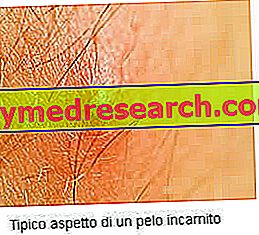What are
The ingrown hairs represent a very annoying discomfort in which the same hairs - instead of developing towards the outside following a semi-vertical trajectory - grow backwards or laterally: finding no escape towards the outside, the hair remains trapped under the skin causing inflammation and redness .

Although harmless, ingrown hairs often cause great discomfort and discomfort, and can sometimes be associated with folliculitis (infection of the respective hair follicles).
Incidence
The problem of ingrown hair often affects young adolescents and adults; more specifically, this discomfort tends to occur more often in African-American individuals and in those who have particularly thick and curly hair (and hair).
Although they can appear anywhere, ingrown hairs tend to develop in areas subject to shaving, such as especially the chin, neck and cheeks (for men), and groin and legs for the woman. When man is used to shaving his head, ingrown hair (hair) can also grow in the scalp.
Causes
What are the Causes and Risk Factors of Ingrown Hairs Formation?
The main cause of ingrown hair lies in an improper or hasty shave. At the top of the list of possible perpetrators, the razor stands out, followed by waxing ("tear" hair removal): after shaving, a tendentially curved follicle encourages the hair to "re-enter" the skin.
The cut of the blade creates rather sharp edges on the tip of the hair, which becomes so sharp as to open up an unnatural way "forcing" the stem to grow laterally or backwards, incarnating in depth.

But why does it happen so often?
Before proceeding with shaving, it is usual to "pull" the skin with your hands to avoid cutting yourself. When the skin is released, the trimmed hair tends to "retreat", therefore to re-enter the skin before regrowing outwards. As there is no escape, the sharp-edged hair grows incorrectly and bends. Furthermore, the opening of the hair to the outside (ostium of the hair) can be hindered by the scar tissue that develops as a result of the micro-cuts caused by the razor; this tissue, together with the accumulation of dead cells, tends to occlude the pilous ostium.
As for waxing hair removal - since with this method the hair is completely ripped, from root to tip - the growth of ingrown hairs is mainly due to obstruction of the ostium of the hair by cellular debris or foreign substances .
Epilation with tweezers can also cause ingrown hairs: this can happen when the hair is not completely removed, in fact only a part of it is torn off. In similar fringes, once grown back, the part of the hair trapped in the skin grows laterally, causing damage.
Risk factors
The habit of wearing tight clothing exposes the subject exaggeratedly to the problem of ingrown hairs. At the same time, even poor hygiene is an element of risk: an excess of dead cells, in fact, can form a sort of cork that closes the outlet of the newly shaved or torn hair, forcing it to grow "under the skin". This is why scrubs and peelings are so effective in preventing the appearance of ingrown hairs.
Signs and symptoms
Just like a foreign body wedged into the skin, even the ingrown hair - penetrating into the "flesh" - is responsible for local inflammation accompanied by itching and burning. Generally, large ingrown hairs become extremely painful when the skin area affected by inflammation is compressed more or less intensely.
When the ingrown hairs are numerous and do not easily regress, they tend to transform themselves and procure papules (solid lesions, detected by the skin surface), small pustules and inflamed boils that sometimes fill with pus. In some cases, ingrown hair can be accompanied by infections (eg folliculitis) and white spots (millet grains).
Complications
Fortunately, most often ingrown hairs are a harmless disorder that heals itself or with the implementation of simple practical measures. However, it can happen that some ingrown hairs that are particularly difficult to eliminate become aesthetically unacceptable and painful. But that's not all: sometimes ingrown hair can cause scars, alteration of skin color (a term that in medical language is called post-inflammatory hyperpigmentation), skin infections and, in the most serious cases, keloids (abnormal growth of fibrotic-scar tissue).
Treatments
Even if an ingrown hair can heal spontaneously, in some cases it is possible to take advantage of some alternative strategies, often effective to accelerate its recovery.
Mechanical removal
To remove an ingrown hair it is possible to obtain a sterile needle and alcohol: with delicate and careful movements, the gently ingrown hair is removed, avoiding to break it during the maneuver. This practice, although effective, is rather dangerous because the risk of bleeding (superficial) or scarring is real. At the end of the operation, moreover, it would be good to disinfect the treated area (for example, with hydrogen peroxide).

Removal with chemicals
As an alternative to needle and tweezers, the depilation chemicals (depilatory creams) can not only remove the ingrown hair but also prevent the hair from becoming incarnate again: this kind of products, in fact, weakens the structure of the hair at point to prevent it from growing backwards. It should however be specified that depilatory creams must never be applied in the presence of cuts, abrasions, cracks, showy pimples or anything else that may damage skin integrity.
Home remedies
Among the various methods that can be used to eliminate ingrown hair, so-called home remedies cannot be omitted, although - in some cases - their actual usefulness is somewhat questionable.
However, the best-known home remedy is probably the one that involves the use of a solution of water and salt to be applied for a few minutes directly to the area in which the ingrown hairs are present: in this way - due to the dehydrating action exerted by the salt - the hair should be eased away from the skin.
Pharmacological treatment
When ingrown hairs cause infection, the doctor can prescribe an antibiotic treatment to be applied daily, even several times a day, on the affected skin area. Oral antibiotics such as erythromycin and clindamycin can be prescribed when ingrown hairs degenerate into pus-infused pustules and cutaneous abscesses.
The use of topical corticosteroids is reserved for severe cases, in which ingrown hair generates considerable inflammation and discomfort.
Furthermore, the creams formulated with cogic acid, salicylic acid, glycolic acid, hydroquinone can be administered (after the doctor's indication) to prevent or to cure the chromatic alteration induced by the indiscriminate growth of ingrown hairs.
Prevention
Although there is no real prevention against ingrown hair, some simple measures can reduce the risk of reappearance. In the following, these measures will be briefly described and some useful tips will also be given which can be followed to avoid, or at least limit, the growth of ingrown hairs.
Before shaving
In order to reduce the risk of formation of ingrown hairs, it is very important to prepare the skin for hair removal. In this regard, it is good practice to shave only after having softened and moistened the skin with warm water: dry or dry skin, in fact, increases the risk of cuts and ingrown hairs.
During shaving
To prevent the formation of ingrown hairs it is necessary to perform the shaving operation correctly. To do this it is necessary to avoid shaving in the opposite direction of hair growth and it is very important not to apply excessive pressure with the razor.
To minimize the risk of ingrown hairs after electric shaving, the advice is to keep the razor head slightly raised, shaving in a circular fashion without exerting too much pressure. It is also recommended not to stretch the skin too much during the procedure.
Furthermore, as far as men are concerned, a good rule is to avoid shaving the beard too much: leaving a very thin bard veil reduces the risk of the hair becoming incarnate.
After shaving
Very important in the prevention of ingrown hair is also the care of the skin at the end of the shaving operations. In fact, moisturizing and nourishing the skin even after depilation is a practice that can soften the sharp points of freshly shaved hair, thus preventing the risk of it becoming incarnate.
Exfoliate the skin
Exfoliate the skin with natural scrubs (like a sugar or salt based scrub; for more details, read "Do It Yourself Exfoliant") is an excellent and effective remedy to avoid the risk of growth of ingrown hairs. In fact, through exfoliation it is possible to remove cellular debris and foreign substances, thus freeing the ostium of the hair and facilitating the growth of the latter.
Similarly, the regular use of a horsehair glove (physical exfoliating) directly on wet skin prevents the formation of ingrown hairs, especially if the operation is performed before and after depilation.
Alternate depilation / hair removal methods
Alternating the various depilatory and epilating methods can sometimes be effective in preventing hair from becoming incarnate.
People who are often affected by this type of disorder - and who are unable to restrict it even by following the precautions and advice so far reported - may possibly make use of alternative epilator methods, such as electrolysis or laser removal, in which it slows down. or prevents the hair from growing back.
Finally, let us remember that an (almost) infallible method against the growth of ingrown hairs is to let them grow.



